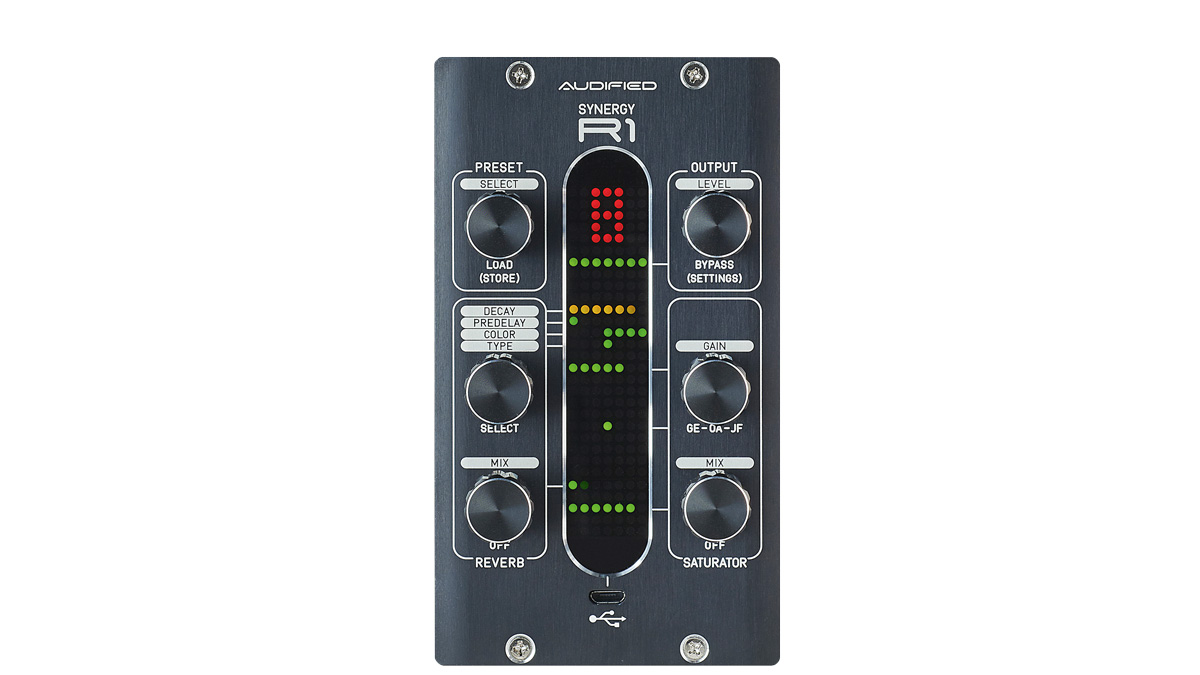MusicRadar Verdict
The Synergy R1 takes two CPU-heavy effects, reverb and saturation, and puts them in a unique double-wide box of excellence.
Pros
- +
High class reverb algorithms.
- +
DAW plugin control via USB.
Cons
- -
Sometimes it’d be nice to put the saturation before the reverb.
MusicRadar's got your back
Instead of churning out a Neve-lite preamp or a FET compressor, Audified’s first foray into hardware sees it pour its digital knowhow into a DSP based stereo reverb and blend it with an all-analogue saturation/distortion effect.
The Synergy R1 comes as a two-slot 500 series unit with two rows of three knobs flanking an LED display and USB socket (for plugin control).
The digital front half of the R1 offers seven acoustic/mechanical reverb types: small room, room, hall, long hall, spring, plate and tunnel. The controls are simple: a push switch knob for toggling the four parameters (Decay, Pre-delay, Color and Type), and another for mix/ bypass. All knob movements are displayed at the top of the LED in numerical form, with lateral dot bars parallel to the control legending. The interface is economical and clear, with enough feedback to make adjustment quick and easy.
The Saturation section follows reverb in the signal flow and features even simpler controls: saturation Gain (click for type) and Mix (click to bypass saturation). The three saturation types refer to the analogue amplifiers on the PCB: Germanium, Op-Amp and JFET. The gain structure is such that their harmonic distortion characteristics run from subtle to distorted (more below).
Audified has created a unique, easy-to-use and sonically-rewarding addition to the 500 series, and its quality is reflected in the price
The seven reverbs are individually excellent and offer as much range as you ever really need, and though the plate and spring types are quality takes on mechanical reverbs, the room and hall algorithms really stand out. From short reflections to bring a dry source to life, all the way through to cavernous swells, the R1 manages to be both a great studio mix tool and a creative source. The tone control (Color - sic) is well shaped to sit the effect where you need it, easily converting ‘pretty good’ to ‘that’s the one’. We’re used to parameter-laden reverbs, so the R1 makes a pleasing and inspiring change, and we miss nothing.
Adding a little distortion to reverb often takes the sound to the next level, especially with digital sources. It’s quick to dial up an appropriate reverb on the R1 and roll through the saturation types, balancing the Gain and Mix controls to taste. Whether as an ‘activator’ for reverb or as an effect on its own, the saturation offers distinct flavours, though the Germanium is an immediate favourite, gently fuzzing out all manner of material, from drums to soft pads. The Op-Amp brings bite, crackling with sustained instruments, while the JFET crushes low end - lovely on guitars and synths.
The final icing on the cake here is the DAW control plugin (AAX, AU and VST compatible). Once hooked up via USB, the plugin brings up the controls to tweak and automate to your heart’s delight, while the presets can be named and stored. The highlight is automating a hardware distortion from your sequencer.
Audified has created a unique, easy-to-use and sonically-rewarding addition to the 500 series, and its quality is reflected in the price. The Synergy R1 is no play thing but rather a high quality creative tool for those with passion.
“Chinese Democracy was a boring record. But calling it Guns N' Roses was not honest. It was totally a solo record”: GN’R’s ex manager takes aim at Axl Rose
“Instead of labouring over a perfect recreation, we decided to make an expanded counterpart”: Chase Bliss teams up with Mike Piera for Analog Man collab based on the legendary King Of Tone
“It’s about delivering the most in-demand mods straight from the factory”: Fender hot-rods itself as the Player II Modified Series rolls out the upgrades – and it got IDLES to demo them










